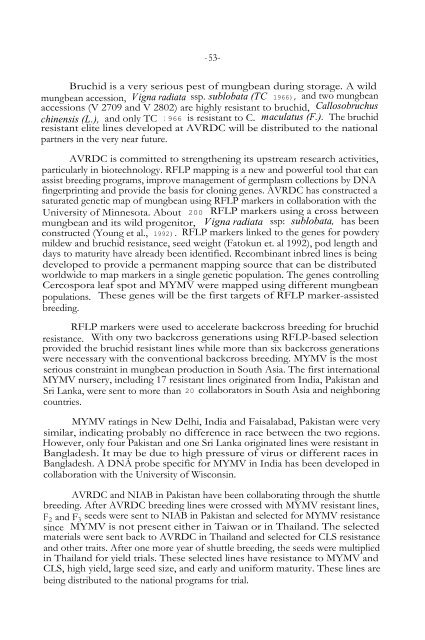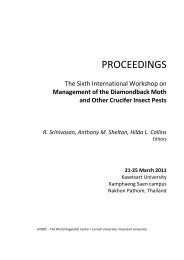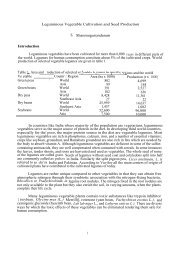MUNGBEAN VARIETAL IMPROVEMENT S. Shanmugasundaram
MUNGBEAN VARIETAL IMPROVEMENT S. Shanmugasundaram
MUNGBEAN VARIETAL IMPROVEMENT S. Shanmugasundaram
You also want an ePaper? Increase the reach of your titles
YUMPU automatically turns print PDFs into web optimized ePapers that Google loves.
- 53-<br />
Bruchid is a very serious pest of mungbean during storage. A wild<br />
mungbean accession, Vigna radiata ssp. sublobata (TC 1966), and two mungbean<br />
accessions (V 2709 and V 2802) are highly resistant to bruchid, Callosobruchus<br />
chinensis (L.), and only TC 1 966 is resistant to C. maculatus (F.). The bruchid<br />
resistant elite lines developed at AVRDC will be distributed to the national<br />
partners in the very near future.<br />
AVRDC is committed to strengthening its upstream research activities,<br />
particularly in biotechnology. RFLP mapping is a new and powerful tool that can<br />
assist breeding programs, improve management of germplasm collections by DNA<br />
fingerprinting and provide the basis for cloning genes. AVRDC has constructed a<br />
saturated genetic map of mungbean using RFLP markers in collaboration with the<br />
University of Minnesota. About 200 RFLP markers using a cross between<br />
mungbean and its wild progenitor, Vigna radiata ssp: sublobata, has been<br />
constructed (Young et al., 1992). RFLP markers linked to the genes for powdery<br />
mildew and bruchid resistance, seed weight (Fatokun et. al 1992), pod length and<br />
days to maturity have already been identified. Recombinant inbred lines is being<br />
developed to provide a permanent mapping source that can be distributed<br />
worldwide to map markers in a single genetic population. The genes controlling<br />
Cercospora leaf spot and MYMV were mapped using different mungbean<br />
populations. These genes will be the first targets of RFLP marker-assisted<br />
breeding.<br />
RFLP markers were used to accelerate backcross breeding for bruchid<br />
resistance. With ony two backcross generations using RFLP-based selection<br />
provided the bruchid resistant lines while more than six backcross generations<br />
were necessary with the conventional backcross breeding. MYMV is the most<br />
serious constraint in mungbean production in South Asia. The first international<br />
MYMV nursery, including 17 resistant lines originated from India, Pakistan and<br />
Sri Lanka, were sent to more than 20 collaborators in South Asia and neighboring<br />
countries.<br />
MYMV ratings in New Delhi, India and Faisalabad, Pakistan were very<br />
similar, indicating probably no difference in race between the two regions.<br />
However, only four Pakistan and one Sri Lanka originated lines were resistant in<br />
Bangladesh. It may be due to high pressure of virus or different races in<br />
Bangladesh. A DNA probe specific for MYMV in India has been developed in<br />
collaboration with the University of Wisconsin.<br />
AVRDC and NIAB in Pakistan have been collaborating through the shuttle<br />
breeding. After AVRDC breeding lines were crossed with MYMV resistant lines,<br />
F 2 and F 3<br />
seeds were sent to NIAB in Pakistan and selected for MYMV resistance<br />
since MYMV is not present either in Taiwan or in Thailand. The selected<br />
materials were sent back to AVRDC in Thailand and selected for CLS resistance<br />
and other traits. After one more year of shuttle breeding, the seeds were multiplied<br />
in Thailand for yield trials. These selected lines have resistance to MYMV and<br />
CLS, high yield, large seed size, and early and uniform maturity. These lines are<br />
being distributed to the national programs for trial.

















